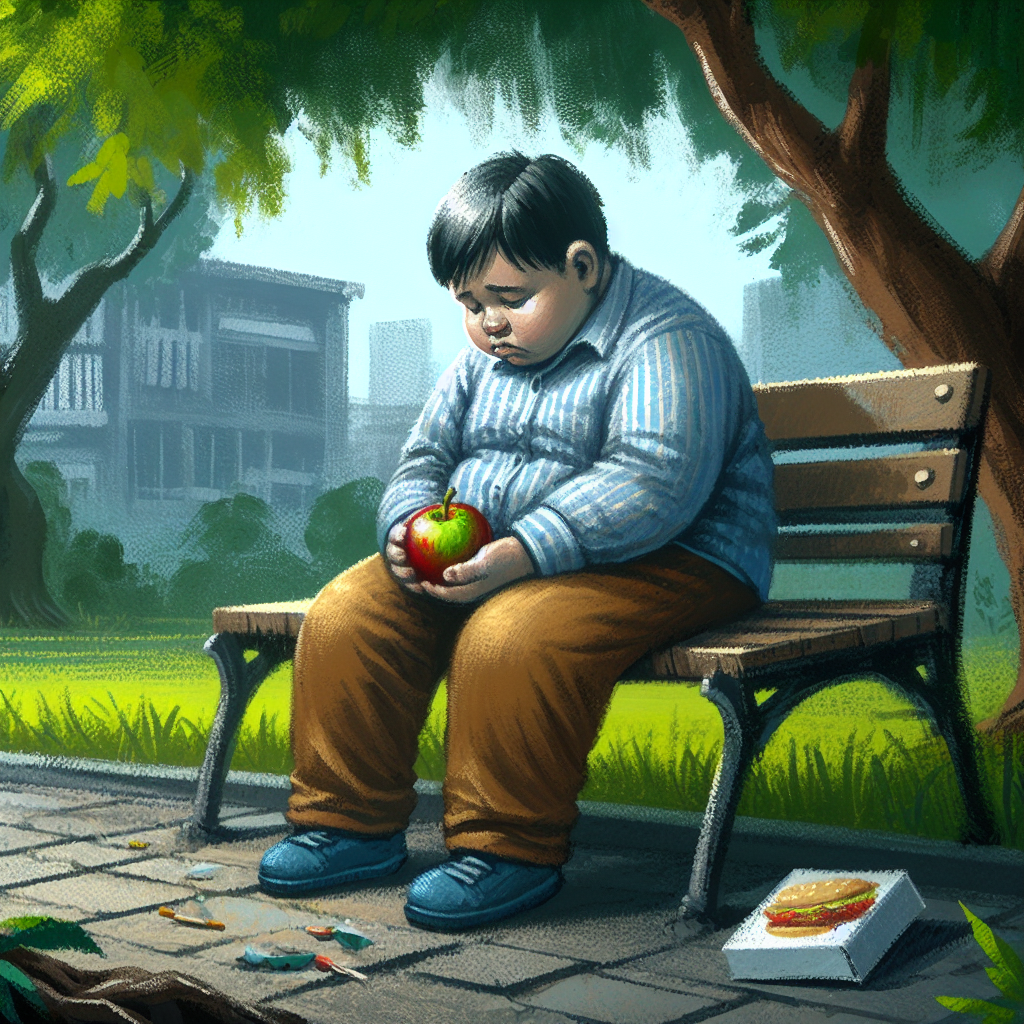Childhood Obesity
In the vibrant landscape of youth, there resides a hidden giant that menaces our generation’s future – childhood obesity. A disquieting presence that stealthily creeps into homes, silently reshaping the innocence of play, meals, and growing up. As we examine the stark reality within the folds of this disturbing phenomenon, it becomes unmistakably clear that stemming the tide of childhood obesity requires not just awareness but an active society committed to holistic, sustainable changes.

Understanding Childhood Obesity
As we delve deeper into the issue of childhood obesity, it’s crucial to find a common point of understanding. It’s an excess amount of body fat that, if not addressed, could lead to serious health complications. It isn’t a circumstance of just being a bit overweight or having a few extra pounds. Childhood obesity is a severe medical condition that impacts children and adolescents, often journeying with them into their adult lives.
Definition
Childhood obesity is a complex health issue, defined not only by excess body fat but also by the dire health effects it carries. It’s not simply a matter of appearance or size but rather an intricate network of issues linked to diseases such as diabetes, heart complications and hypertension, to name a few.
Difference between Obesity and Overweight
Now imagine a scale with three notches: underweight, normal weight, overweight, and obese. While often used interchangeably, obesity and being overweight mean different things. Children who are above the standard weight for their height and age are considered overweight, while obesity is a step beyond that, a level where excess weight is accompanied by health risks.
Obesity vs Unhealthy Weight Gaining
Unlike unhealthy weight gaining, obesity is a chronic condition with multifactorial origins not contained to simple overeating. Unhealthy weight gaining can be a transient stage in growth and development or connected to short-term lifestyle changes. Obesity, on the other hand, is persistent and seldom resolved without intervention.
Causes of Childhood Obesity
We can liken the causes of childhood obesity to a tangled web. It’s not just one factor at play—it’s a multitude of them: genetic factors, lifestyle choices, societal influences, and eating habits.
Genetic Factors
Our genes play a role in our weight. In some cases, children inherit obesity tendencies from their parents. So, if a child comes from a lineage of obese individuals, they may be more at risk.
Lifestyle Choices
The sedentary lifestyle of modern age children majorly contributes to their likelihood of becoming overweight. The time once spent on physical activities is now consumed with video games, television, and mobile devices.
Societal Influences
Our society, with its fast-paced life, heavily relies on instant gratification, which puts processed, easily accessible food on our tables. These high-calorie, low-nutrient foods contribute significantly to obesity.
Eating Habits
The trend of increased portions, frequent snacking, and eating meals outside the home contributes to childhood obesity. This, coupled with a high intake of sugar-sweetened drinks, leads to an upward spiral in childhood weight.
Prevalence of Childhood Obesity
Global Statistics
We find ourselves in a world where childhood obesity is reaching alarming proportions. Global statistics reveal that approximately 200 million school-aged children are either overweight or obese, creating a heavy toll on their health and quality of life.
Increasing Rates
The rates of childhood obesity have been on a steady rise. The last four decades have witnessed a tenfold increase, leading to severe health consequences for children worldwide.
Demographics with Higher Risk
Specifically, children from low-income families and certain ethnic groups show higher rates of obesity. The interplay between genetics, environment, culture and socio-economic status in these demographics leads to a higher risk.
Complications Associated with Childhood Obesity
Childhood obesity bears down heavily on the life of a child, bringing about physical, psychological, and even long-term health complications.
Physical Complications
Beyond the visible body mass, childhood obesity is the silent orchestrator of numerous health issues. These include the risk of type-2 diabetes, high cholesterol levels, high blood pressure, bone and joint problems, sleep apnea, and even early signs of heart disease.
Psychological Complications
Talking about a burden carried within, obese children often suffer from low self-esteem, negative body image, and depression due to bullying and societal pressure.
Long Term Health Outlook
Childhood obesity, if not addressed, often tracks into adult life, leading to long-term health problems such as heart disease, type 2 diabetes, stroke, several types of cancer, and osteoarthritis.

Diagnosis of Childhood Obesity
Diagnosing childhood obesity isn’t as straightforward as stepping on a weighing scale. It’s much detailed and involves a physical examination, the body mass index, and waist circumference measurement.
Physical Examination
A comprehensive physical examination would consider a child’s history, growth pattern, developmental history, physical activity, screen time, sleep schedule, and family’s obesity-related history.
Body Mass Index (BMI)
The Body Mass Index is a handy tool used to screen for obesity in children. It considers the weight and height of the child, and their age and sex to determine if they are within the expected range for a healthy child.
Waist Circumference Measurement
Though not a routine gauge, the measurement of waist circumference helps to determine body fat distribution and further risk for obesity-related complications.
Prevention of Childhood Obesity
Yes, we do agree, prevention is better than cure. This statement rings extra true in the case of childhood obesity. Key to this is instituting a healthy diet, encouraging regular physical activity, reducing screen time, and promoting healthy sleep habits.
Instituting a Healthy Diet
A healthy diet is an integral part of preventing childhood obesity. It’s not just what the child eats, but also how much and when. This includes boosting intake of fruits, vegetables, lean proteins, and whole grains, and curbing sugary drinks and high-calorie foods.
Encouraging Regular Physical Activity
Physical activity goes hand in hand with a healthy diet in preventing obesity. It keeps children fit, helping to control their weight while promoting better sleep and building a healthier heart, lungs, and muscles.
Reducing Screen Time
Our omnipresent screens have taken a toll on children’s physical health. It’s important to limit screen time and promote other engaging activities, ultimately lowering the risk of obesity.
Promoting Healthy Sleep Habits
Like the missing pieces of a puzzle, proper sleep patterns are crucial in preventing childhood obesity. Regular inadequate sleep can lead to modifications in hormones that regulate hunger and satiety, pushing children towards overeating.

Treatment of Childhood Obesity
In situations where prevention steps fail, treatment becomes inevitable. This intricate process involves behaviour modification, medications, weight loss surgery, and psychological support.
Behaviour Modification
This is the first line of action and involves a structured program to help institute healthy eating patterns, increase physical activity, and reduce screen time. It aims to help children establish lifelong habits.
Medications
In certain cases, when lifestyle and behavioural modifications don’t yield significant results, medication is prescribed. Such medications either decrease appetite or inhibit fat absorption and should always be overseen by a medical professional.
Weight Loss Surgery
Though rarely performed in children, weight-loss surgery could be considered in severe cases where other methods have proven ineffective and if the child’s weight poses grave health concerns.
Psychological Support
It’s crucial not to forget the emotional aspect. Psychological support, including counselling and group therapy, helps children cope with societal pressure and low self-esteem, enabling them to lead healthier lives.
Role of Parents in Managing Childhood Obesity
Parents undoubtedly play a pivotal role in shaping their child’s health. They can assist in managing childhood obesity by creating consciousness about healthy eating, promoting an active lifestyle, and modelling healthy behaviour.
Creating Consciousness About Healthy Eating
Educating children about the importance of nutritious food plays a significant role in their health. Parents need to make sure their children know the difference between healthy and unhealthy meals, and adhere to balanced meals regularly.
Promote Active Lifestyle
Parents can encourage children to adopt an active lifestyle. This could include involvement in physical activities, games, and sports. An active child is significantly less likely to become obese.
Modelling Healthy Behaviour
Children often learn and imitate what they see. As parents, modelling a healthy lifestyle including balanced eating, being physically active, and maintaining a healthy sleep schedule provides a living blueprint for their children.

Role of Schools in Addressing Childhood Obesity
Education and the Food and Nutrition Service’s role go hand in hand in addressing childhood obesity. Schools can implement healthy cafeteria options, physical education, and nutritional education.
Healthy Cafeteria Options
School cafeterias can be an essential tool in fighting obesity by offering healthier, appealing food choices, reducing unhealthy options and promoting sensible eating choices among students.
Physical Education and Active Recess
Aside from academics, physical education and active recess should be an integral part of the school curriculum. Sports, games, and other physical activities can help to manage and prevent childhood obesity.
Nutrition and Health Education
Educating students on nutrition and health can go a long way in empowering them to make healthier choices regarding their diet and physical activities, translating to healthier lifestyles.
Role of Government in Addressing Childhood Obesity
Governments bear a significant responsibility in addressing childhood obesity. They can take up roles such as policymaking, institution of health programs and promotion of nutritional food access.
Policy Making
Inspired policies can play a vital role in controlling childhood obesity. Policies that regulate marketing of high-calorie food and support physical education programs in schools can make a noteworthy difference.
Institution of Health Programs
Government can put forth health programs focusing on obesity prevention, such as improving access to healthy food options and creating safer neighbourhoods for physical activities.
Promotion of Nutritional Food Access
Governments can also play a critical role by encouraging farmers to produce more nutritious foods and making these foods available to everyone at affordable prices.
Indeed, addressing the issue of childhood obesity is not easy. However, collectively, we have the tools—awareness, education, policy making, and healthy community environments. We must act now to ensure a healthier future for our children. Let’s untangle the web of childhood obesity together.



Pingback: Which Of The Following Is A Characteristic Of Obesity In Childhood?
Pingback: What Does Obesity
Pingback: How Many People Die Of Obesity
Pingback: What Conditoin Has Been Related To Childhood Obesity
Pingback: How To Solve Food Insecurity And Childhood Obesity
Pingback: Obesity In Children: Why Is It Becoming Such A Problem